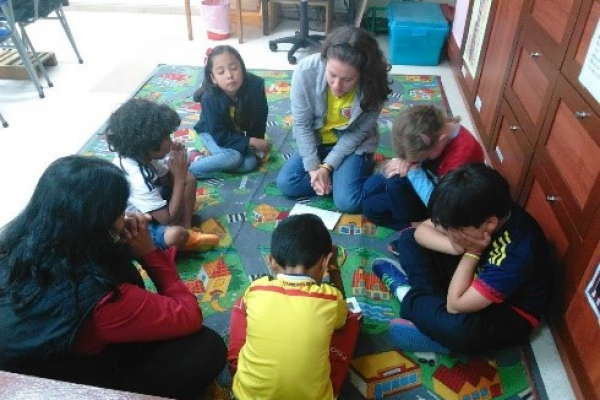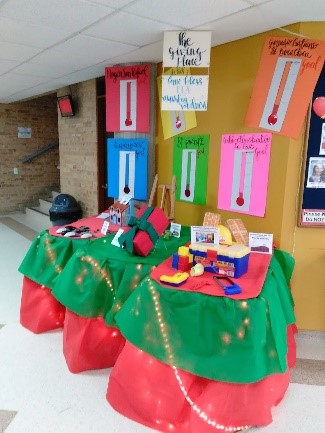Building Class Identity

Welcoming a new class at the beginning of the school year can be both exciting and overwhelming. One big question teachers think about is who their class will be as a group. How can I as a teacher be intentional about creating a safe, loving, and Christ-centered classroom community so that learning can happen?
Paul explains to the church in Ephesus that spiritual growth comes through the community of believers growing together towards maturity.[1] It is not just an individual activity. As an extension of the Church, classrooms can become places of healthy Christ-striving community. With guidance from the Holy Spirit, as well as some planning, transformed teachers can create an excellent educational environment with a strong class identity. Here are three questions that can help teachers consider how to build a unique identity for each class they teach:
How can we grow closer to God together?
As followers of Jesus, we have practices that not only grow us closer to one another, but also to God.
- Pray Together: A fourth grade teacher kept a white board in the back of her room for prayer requests, then during closing time they would pray for the requests, erase what had been answered and add new petitions.
- Serve Together: An elementary teacher did a clothing drive for a local homeless shelter with her class. The students set a goal and encouraged each other to clean out closets at home and fill up bags for donations. They together then prayed for those who would receive the clothing items that they would know the love of God.
- Adopt a People Group: Because I had lived in Mali for 2 years, I was able to share with my students what life was like in another country, and we would pray for the unreached people in Mali. It was not only a connection with each other but also a personal connection with the teacher as I shared stories and pictures.
What traditions can we celebrate as a class?
Traditions don’t have to be complex or elaborate and often can connect to the curriculum or subject area you are teaching.
- Once a Year: A high school math teacher celebrates “Pi” day with her students every year by bringing in pie on March 14th (3.14). This simple, yet predictable tradition connects the students in her class with yummy food and students looked forward to it every year.
- Ongoing Routine: A third grade teacher had a class stuffed monkey – Mr. Banana. Throughout the year the students would take Mr. Banana outside to play with them on the playground, and he even got to visit their homes on the weekend. By the end of the year, the students decided it was sad to have Mr. Banana be alone, so they brought a “Ms. Banana” and planned a wedding for the two monkeys. Years after the students moved on from third grade, they would go back to the classroom and check on Mr. and Mrs. Banana and make sure they were doing well.
What can we do to embrace the spontaneous moments?
When reflecting on my learning and teaching experiences, it is most often the unplanned moments in class that I remember. When students feel safe to enjoy being in class together, moments of funny answers, interesting anecdotes, unique mistakes, and timed vulnerability bond a class. Although these moments cannot be planned, the attitude of the teacher can welcome openness and sharing – even in the silly.
It can also be the hard moments that are used to build community. One fifth grade teacher recently reflected on a hard day her class was having. Instead of allowing the anger to fester, she used class time to stop, reflect, and talk about their strong feelings. Students drew pictures to help communicate with one another. The day ended on a positive note due to a teacher’s sensitive heart to the climate of the classroom.
And here are a few bonus ideas:[2]
- Take photos and display them in the classroom to show how students have progressed throughout the year or keep a scrapbook of major events and experiences throughout the year.
 Use bulletin board space to show collages of the interests students have in common, their contributions to the class, and personal quotations or mottos that are important to them.
Use bulletin board space to show collages of the interests students have in common, their contributions to the class, and personal quotations or mottos that are important to them.- Set goals as a class and work together to reach them. Examples include: the entire class earning a certain grade, going a certain number of days without tardies, earning a specified class average on a test, or striving for a perfect homework completion rate.
- Adopt a class mascot, secret sign or catchphrase.
- Observe milestones such as the 20th homework assignment or the 10th day with no tardies or the 100th day of school.
By taking the time to pray, plan and prepare, teachers can be intentional in creation a safe classroom for student learning.
“Few things can establish a sense of community in a classroom as quickly as shared experiences and shared tasks. Students who learn to see themselves as a united group working and playing together quickly learn to be supportive of each other’s efforts and tolerant of each other’s idiosyncrasies.”[3]
Take time to Reflect:
- What experiences while learning helped you feel part of the group?
- How did the teacher provide that experience?
- What environment did the teacher create to allow for class unity?
Sarah Trussell
Associate Regional Director, Programs
TeachBeyond, Latin America Region
